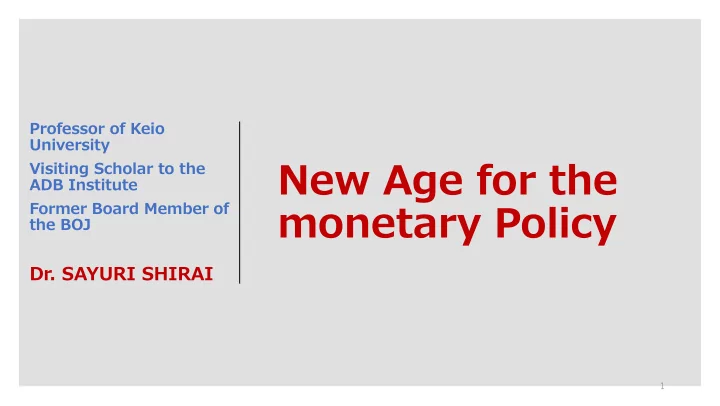

Professor of Keio University New Age for the Visiting Scholar to the ADB Institute monetary Policy Former Board Member of the BOJ Dr. SAYURI SHIRAI 1
OUTLINE OF PRESENTATION • Exchange-Traded Fund Purchases and Five Related Issues Part 1 • Feasibility of the 2% Price Stability Target Part 2 • Searching for a New Monetary Framework Part 3 2
Part 1. BOJ’s ETF (Stock) Purchases and 5 Related Issues 3
Central Banks’ Stock Purchases for Two Reasons Reserve Management Monetary Policy management of counter-cyclical foreign reserves held policy by central banks 4
Gov. Bonds As Main Purchasing Assets • JGB yields are the benchmark for measuring long-term fixed interest rates (mortgages, loans, and corporate bonds). • The decline in the yields will help to raise risk assets (such as stocks) through promoting search for yield due to declined returns on bonds. • The decline in the yields will help to raise risk assets through lowering the discount rate and thus higher PV of cash flows. 5
Why led to BOJ’s Decision to Purchase ETFS? • Exerting downward pressure directly on the risk premia, thereby promoting the stock markets and portfolio rebalancing among individuals. • Promoting a wealth effect directly. • Generating momentum to correct undervaluation of stock prices speedily. 6
What are the ETFs? Listed on the stock exchange. ETFs Track (1) TOPIX, (2) Nikkei 225, (3) JPX-Nikkei Index 400 BOJ indirectly purchases stocks through trust banks. BOJ DOES NOT exercise voting rights. The BOJ purchases about JPY 6 trillion annually. 7
Stock Price and ETF Purchases 8
NIKKEI 225 AND YEN VIS- À -VIS US$ JPY 9
Stock Price and P/E Ratio Issue 1 10
Small- Cap Firms’ Stocks (Nikkei Issue 2 225) Might be Overvalued P/E Ratio: Fast Retailing (38 times); TOPIX (15 times); Nikkei (13 times) 11
Large Stock Holdings by Foreign Investors Issue 3 250 Unit: ¥ Trillions 200 150 100 50 Foreigners Trust Banks Business Corporations Individuals 12 0 2012 2013 2014 2015 2016 2017
Large Stock Transaction by Foreign Investors Individuals Foreigners Unit: ¥ Trillions 13
BOJ becoming Top Shareholders Issue 4 14
Issue 5 Complicated Normalization Process ○ Expanding the Target Range & Raising the 10-Year Yield Target ○ Reducing JGB Purchases to ¥ 20 Trillion ○ Reducing the JGB and ETF Purchases to ZERO ○ Eliminating the 10-year Target Raising Short-Term Policy Rate 15
Part 2. Feasibility of the 2% Price Stability Target 16
CPI Inflation (exc. tax effect) 17
BOJ’s Inflation Outlook (Median) 18
Real GDP and Composition (FY 2006=100) 19
Potential Growth without TFP Contribution Current potential Growth (0.8%) 20
Sluggish Consumption • Households DO NOT feel that income has risen. They DO NOT expect a higher income. • A third of population is more than 65 years old. • The majority of households worry about the post- retirement life (due to insufficient pensions or financial assets) 21
Part 3. Searching for a New Monetary Policy Framework -- Case of Japan -- 22
New Frameworks Discussed Globally • Option 1: Raising the Inflation Target • Option 2: Adopting the Price-level Targeting • Option 3: Nominal GDP Targeting • Option 4: Nominal Wage Targeting 23
Awareness of the 2% Target Opt. 1: Raising and Monetary Policy Inflation Target % of Respondents 24
Households ’ Perceived Inflation and Inflation Expectation 25
Desired and Actual Price Level Opt. 2 (2012=100) Price Level 26
Government Adopted Opt. 3 Nominal GDP Target in 2015 Nominal GDP 27
Nominal and Real Wage Levels Opt. 4 (2000=100) Nominal Wage 28
Discussions Japan on the 2% Price Stability Target in Japan Three Options : • Abandon? • Reducing to 1%? • Adopting ± 1% to the 2% price stability target (1-3%) 29
Conclusions • Purchasing stocks as an unconventional monetary easing has positive impacts on stock prices. At the same time, the effectiveness on inflation and market functioning needs to be carefully examined. Exit policy may be challenging. • The difficulty to achieve the 2% price stability may reflect structural problems (e.g., low wage expectation, concerns about social security system) • Various new monetary policy framework proposals to achieve higher inflation may not be suitable in the cast of Japan. Rather, flexibility on the 2% price stability target may be desirable. 30
Recommend
More recommend